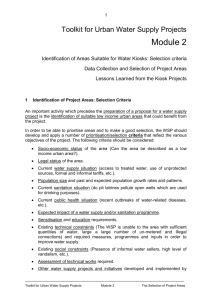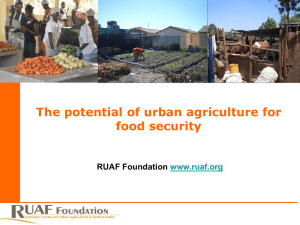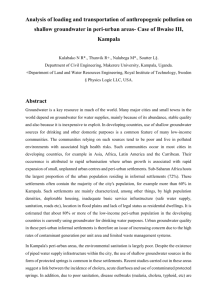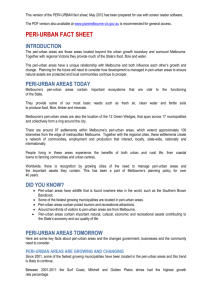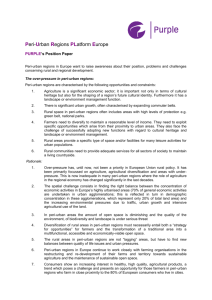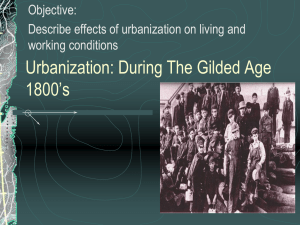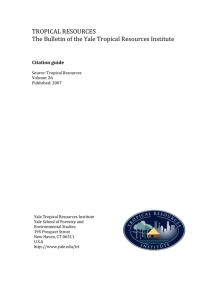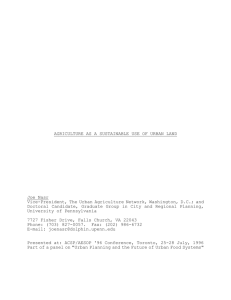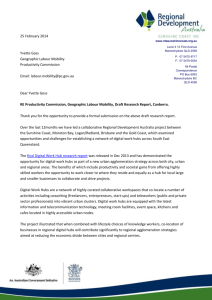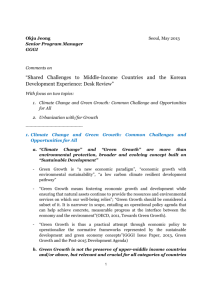Admasu-155-155_paper
advertisement
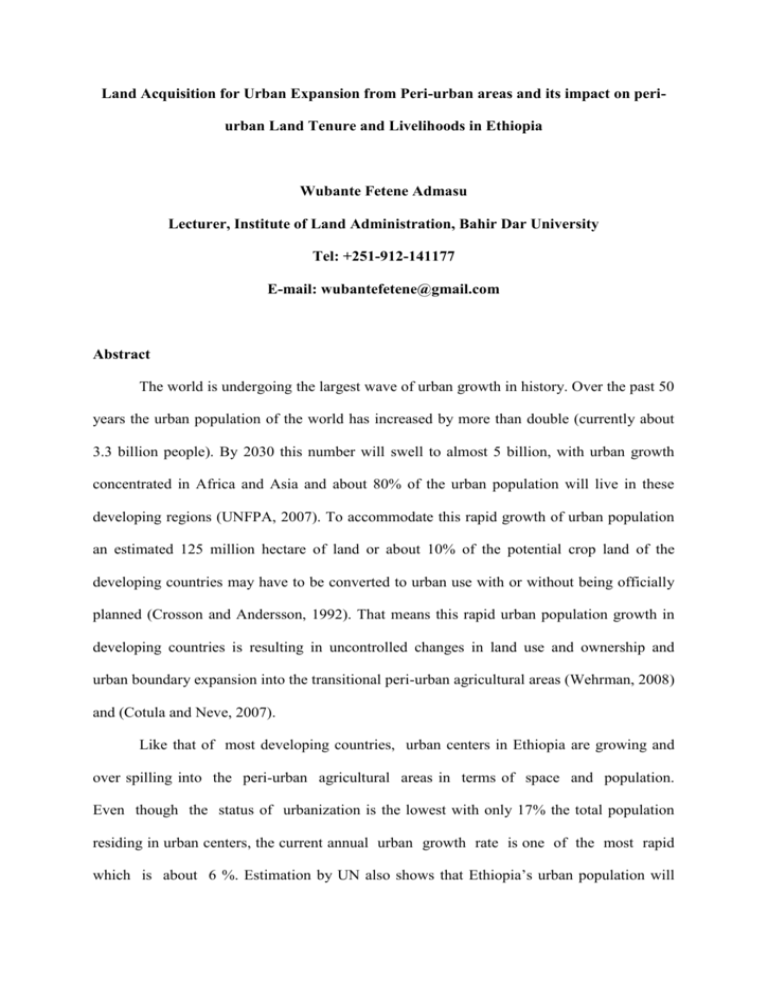
Land Acquisition for Urban Expansion from Peri-urban areas and its impact on periurban Land Tenure and Livelihoods in Ethiopia Wubante Fetene Admasu Lecturer, Institute of Land Administration, Bahir Dar University Tel: +251-912-141177 E-mail: wubantefetene@gmail.com Abstract The world is undergoing the largest wave of urban growth in history. Over the past 50 years the urban population of the world has increased by more than double (currently about 3.3 billion people). By 2030 this number will swell to almost 5 billion, with urban growth concentrated in Africa and Asia and about 80% of the urban population will live in these developing regions (UNFPA, 2007). To accommodate this rapid growth of urban population an estimated 125 million hectare of land or about 10% of the potential crop land of the developing countries may have to be converted to urban use with or without being officially planned (Crosson and Andersson, 1992). That means this rapid urban population growth in developing countries is resulting in uncontrolled changes in land use and ownership and urban boundary expansion into the transitional peri-urban agricultural areas (Wehrman, 2008) and (Cotula and Neve, 2007). Like that of most developing countries, urban centers in Ethiopia are growing and over spilling into the peri-urban agricultural areas in terms of space and population. Even though the status of urbanization is the lowest with only 17% the total population residing in urban centers, the current annual urban growth rate is one of the most rapid which is about 6 %. Estimation by UN also shows that Ethiopia’s urban population will triple between 2010 and 2040. Preliminary city-level population projections suggest that some of Ethiopia’s large cities will be much more than triple by 2040 (UN-Habitat, 2010). For instance, Hawassa’s 2010 population will grow more than 6-fold by 2040, Mek’ele almost 5-fold of its 2010 population, and Adama and Bahir Dar almost 4-fold. The spatial extent (built-up areas) of these cities can also be expected to expand at an even faster rate than their population. One of the greatest challenges to urban policy makers in the Global South in the era of rapid urbanization is providing decent and affordable land and housing (Midheme and Moulaert, 2013). As a response to accommodate the growing demand of land and housing, most governments in sub-Saharan Africa have been employing the conventional and traditional way of acquiring land compulsorily from the peri- urban areas (Toulmin, 2006) and (Durand-Lasserve, 2003). As a consequence, local peri-urban communities around cities are more likely to be displaced and dispossessed from their land in the process of urbanization. In Ethiopia, like elsewhere in the sub-Saharan region, urban growth strategy is primarily based on compulsory expropriation of peri-urban agricultural land from local periurban farmers. Land acquisition and delivery for urban expansion and development purposes are completely state controlled on the rational that all land belongs to the state (FDRE, 1995). As urban territory extends into the adjacent peri-urban areas, expropriation of peri-urban land by local government (urban administration) is an inevitable. Because, it is only through expropriation that peri-urban agricultural land can be converted to urban land and it is also the only formal means to supply land for urban development in Ethiopia. The peri-urban land acquired compulsorily by state from local peri-urban landholders/farmers is expected to be reallocated to urbanities through lease contract for urban construction purposes. Another problem in the process of expropriation for urban expansion in Ethiopia is that there is unjustifiable disregard of land value in the amount of compensations paid to those people expropriated from their land (Alemu, 2013) and (Anteneh, 2007). Due to the assumption that all land belongs to the state (FDRE, 1995), local peri-urban landholders can be provided compensation only for improvements on land, i.e. buildings and structures on the land (FDRE, 2005), without taking into consideration the land values. It seems clear that urbanization and urban based economic development in Ethiopia is expected to be achieved through the sacrifice of the local peri-urban landholders/ farmers’ interests. As the demand of land for urban development purpose arises, local peri-urban landholders/farmers adjacent to the municipal boundary are obviously expected to lose their land on which their families have lived for generations(Adam, 2014). This compulsory and rapid land tenure transformation through expropriation has been generating a number of problems in the peri-urban areas such as: tenure insecurity and widespread sense of fear to loss land; unregulated land development; informal transaction of land and proliferation of informal settlements. Thus, the land acquisition process from peri-urban areas for urban expansion Purposes is criticized for being top down and unfair for those local peri-urban communities from whom land is compulsorily acquired (Fekade, 2000). In spite of the seriousness of peri-urban agricultural land problems associated with rapid urbanization, no comprehensive research and investigation has been done on the effects of urbanization on peri-urban agricultural land and its impact on the livelihoods of the local communities in the transitional areas of Ethiopia. So, it is difficult to precisely tell the state of land right and livelihood issues in the transitional peri-urban areas of Ethiopian cities where the land is highly demanded for urban purposes. Therefore, the primary purpose of this research project is to investigate and demonstrate how local periurban landholders/farmers in Ethiopia are vulnerable and insecure as a result of urbanization and compulsory changes in land rights through expropriation. The challenges and pressures imposed on peri-urban land rights as a result of the growing demand of land for urbanization and the pattern of rural and urban landholding arrangements will also be examined based on property rights analytical framework. This research project will present the challenges, prospects and trends of land acquisition for urban expansion from the transitional peri-urban areas with an emphasis to the selected large cities of Ethiopia. A mixture of desk review and survey research approach will be employed to undertake this research project. A combination of primary and secondary data sources will be used so as to capture important and relevant information. Primary data for this research will be collected by using questionnaire survey, key informant interview, Focus Group Discussion (FGD) and Direct observation. The main targets as sources of primary data will be peri-urban landholders/farmers, community representatives, urban and rural land administration experts and officials. In addition, this research covers an intensive desk review of contemporary theories and literatures on urbanization which have relevance to this specific research project. The complementary sources of information will be used as a means to validate the reliability of information gathered from different sources. The uses of multiple sources of evidence in this research project allow the investigators to address a broader range of issues under investigation. Thus, the research findings in all study areas to be much more convincing and accurate, different sources of information and data collection tools will be used in this research project. Moreover, orientations and trainings to data collectors/assistants and continuous supervisory visits before and during questionnaire surveys, FGD and key informant interviews will also be undertaken as an input and quality management strategy. The overall approach of this research project composes the following major components. As a conclusion and recommendation to the overall finding of this research project, an inclusive and innovative land development tool that can meet the requirements of the dynamic peri-urban areas will be explored and recommended to be introduced to the Ethiopian urban land planning and development system. It is also expected that the research result will give feedbacks to concerned development actors of urban development to evaluate past development actions of urbanization and identify further intervention areas. Moreover, the outcomes of this research will help policy makers to draw lessons to sustainable urban, peri-urban, and rural development policy formulation. The research result will also be used as a complementary reference to the hardly existing urbanization evaluation literatures. Key Words: Land, Urban expansion, land acquisition, livelihoods, land tenure
